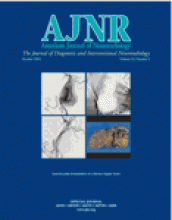In this issue of the AJNR, Abud and colleagues report their experience with direct percutaneous injection of cyanoacrylate for preoperative devascularization of head and neck paragangliomas (1). They achieved impressive results in nine patients, with angiographic and clinically complete devascularization in five cervical tumors. No complications related to the embolization procedure were observed.
Paragangliomas, or glomus tumors, are uncommon neoplasms of the head and neck. They are remarkably vascular and surgical resection can be complicated by rapid and dramatic blood loss. Safe and relatively effective transarterial embolization techniques have been made possible by the same advances in imaging and catheter design that have allowed the routine endovascular treatment of intracranial aneurysms. However, while transarterial embolization may be effective in reducing operative blood loss, it by no means eliminates it. This is attributable to several factors, the primary one being the frequent presence of very small feeding branches from the internal carotid or vertebral arteries that cannot be directly catheterized.
In an effort to overcome this well-recognized limitation, investigators from two different groups, including authors of the present study, developed the technique of direct injection of cyanoacrylate from a percutaneous approach. These first two reports were published 10 years ago (2, 3). While this method certainly results in more complete reduction of tumor vascularity, it has not been widely adopted. There may be several reasons for this, but a key issue is the unanswered question of whether the additional risks of this technique outweigh the benefits.
Risks specific to the direct injection technique can be broken down into four components: distal embolization of glue, chemical toxicity, hemorrhage risks from direct puncture, and procedural risks of general anesthesia. None of these complications were encountered in this small series. The risk for distal glue embolization is real. Casasco et al (4) reported a large series of 65 hypervascular head and neck tumors, including 22 paragangliomas, treated with direct intratumoral injection of cyanoacrylate. They observed distal ischemic complications in two patients with juvenile angiofibromas. Glue was inadvertently injected retrograde into a distal internal carotid artery branch, ultimately occluding the distal middle cerebral artery in one patient and the ophthalmic artery in another. They emphasized the careful inspection of direct injections of contrast medium in multiple planes before the injection of glue, as well as the use of more concentrated glue suspensions (50% N-butyl −2-cyanoacrylate [NBCA]) to achieve more rapid polymerization. This second recommendation runs counter to the recommendations of the present series (20% NBCA plus an additive to extend polymerization time). The risk for distal embolization will be greatest for skull base tumors.
None of the limited data to date have described chemical toxicity of NBCA on cranial nerves or other intracranial or intralabyrnthine structures. This remains a possibility, however, particularly in skull base tumors in contact with these structures. Similarly, hemorrhagic complications in the soft tissues of the neck or within the cranial vault were not observed here, but could certainly occur. Preprocedural arrangements for possible emergent surgical care would be reasonable, until more experience is gained.
Finally, the need for general anesthesia adds an invasive procedure to the care of these patients, in addition to the inherent risks of general anesthesia. For example, a balloon occlusion test or simply diagnostic angiography may be necessary before determining whether percutaneous injection under general anesthesia is necessary or feasible. In contrast, transarterial embolization can be performed at the time of the diagnostic angiography or following the balloon occlusion test.
The final and most important issue is that of effectiveness. While transarterial embolization has become widely accepted as a preoperative adjunct to reduce blood loss with resection, there is no level-one evidence to support this practice. The best data are from a nonrandomized single center case series (5). Whether the risks of direct tumoral injection are outweighed by the benefits of the procedure remains to be established. To study this in the most rigorous manner, an accurate and precise measurement of residual tumor vascularity needs to be developed. Postcontrast volumetric CT or MR studies could provide this information. Postprocedural CT findings were obtained in the present series but their results are not presented. The relationship between the degree of devascularization, objectively measured, and operative blood loss could be investigated. Given the infrequency of these lesions, a randomized study would be difficult to perform.
In summary, this method has potential and should be considered for the management of selected patients with head and neck paragangliomas and other hypervascular tumors. There are several risks specific to this technique, and whether these risks are worth it remains to be determined.
- Copyright © American Society of Neuroradiology












